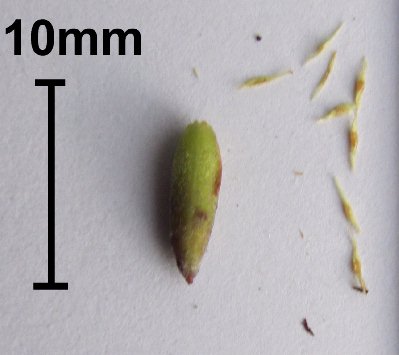Mar
2016
Deciduous Shrub Cutting
Butterfly Bush Propagation
Introduction
Buddleja davidii, commonly refereed to as Butterfly Bush, Summer Lilac or Orange Eye, is seen in landscapes spanning several continents.

“Orange Eye” is a common nickname for this plant species due to the orange color seen on the inside of the flower
The plants point of origin is China, but it’s cultivar can be found in Africa, Southern Asia, North America and South America. In the Buddleja genus one may expect to encounter a variety of shrubs and short-living, small trees. Most species in this genus fall under the deciduous category with few exceptions in which members exhibit evergreen properties. In recent years Butterfly Bush has been dubbed a “vogue” landscape element due to a new wave of cultivars.
Shrubs stand between 5 to 10 feet tall and wide. Long, slender branches that arch in various directions provide a colorful, fragrant addition to landscapes. Branches contain leaves of grey, green or dark green color and span about 4-10 inches in size. Complimenting the leaves are panicles of small, tubular flowers found on branch tips and clustered along the mid sections. The species in this genus produce a large array of colors such as white, pink, lavender, blue and deep purple.
The color and fragrance are known to entice butterflies to feed on the plants nectar, resulting in the commonly know name Butterfly Bush.

A peacock butterfly rests on a Buddleja davidii http://www.gardenseeker.com/shrubs/images/Peacock%20Butterfly%20on%20Buddleja%20davidii-DSC_8252.JPG%5B/caption%5D
The shrub is highly adaptable and is able to flourish in landscapes that provide full sun. Members of the Buddleja family prefer well-drained, loamy soil with a pH between 6 and 7. Once established, the shrub will be able to tolerate heat and drought. However, Buddleja davidii’s resilient qualities can become invasive if not properly pruned and maintained. Plants of this variety require hard pruning to control their unkempt appearance. Branches should be cut back in the late winter to about 12-18 inches. It is important to then fertilize the freshly pruned branches to ensure regeneration of the plant stalk.
Propagation
Methods:
This annual woody shrub can be propagated using various different techniques. These techniques include utilizing seeds from a preexisting bush, collecting cuttings or dividing an established brush. Tissue culture is an excellent method for plants that prove difficult to propagate. However, its high cost and labor requirements hinder its use. Especially with such a species as easy to grow as Buddleja davidii.
Division:
Butterfly Bush, and plants that have multiple stems emerging from the ground, can be propagated utilizing the technique of division. Division is a rather simple method and should be carried out in early spring when plant is either dormant or about to break dormancy. If the deciduous plant has already developed its leaves in the spring, a successful division nearly impossible. Propagation via division should be postponed until late fall to avoid putting the plant in shock.
Once a parent plant is selected, remove excess debris and smooth soil from around the stems of the bush. This will give you a better idea of the plant’s root system. Using a spade, shovel or hands remove the entire plant, including the root system from the ground. Divide the parent plant into equal sized pieces. Trim the roots of the new propagates as necessary and plant the new individuals in desired location.
[caption id="" align="alignnone" width="800"] Image demonstrating a successful division of a softwood plant
Image demonstrating a successful division of a softwood plant
Seed:
Seeds may be purchased or sown from a previously existing Butterfly Bush. Use a potting mix that is equal part perlite and peat moss or peat moss equivalent. Since the plant needs large amounts of sunlight, use no more than a quarter inch of solid to cover the seed. Keep the potting mix at about 70 degrees farenheight and ensure the mix moist but using a spray bottle or mist system. Germination should occur in roughly three weeks.
Cutting:
One of the best ways to propagate deciduous shrubs is by taking cuttings of branches from a stock plant. To ensure success of you cutting it is important to choose a healthy stock plant. Make sure panicle color is vibrant and inspect for possible insect infestation or disease. Cuttings should be executed during the spring or summer. They should be taken from the branch tip and measure about three inches long. An angled cut of the plant stem will allow for easier rooting ad better nutrient absorption.
Remove bottom most leaves from cutting and pinch off the tip to promote bushier plants.

The end product of your cutting should look similar to the image above
To promote adventitious rooting dip the end of the cutting into 1,000-3,000ppm of indole butyric acid or IBA for short. Place into appropriate potting mixture. Plant roots should begin to appear in around 3 weeks.
Sources
Botanica’s Trees & Shrubs: Over 1000 Pages & over 2000 Plants Listed. San
Diego, CA: Laurel Glen, 1999. Print.
Dirr, Michael A. Dirr’s Encyclopedia of Trees and Shrubs. Portland: Timber,
2011. Print.
Greer, Lane, and John M. Dole. Woody Cut Stems for Growers and
Florists: How to Produce and Use Branches for Flowers, Fruit, and
Foliage. Portland, Or.: Timber, 2009. Print.
McGroarty, Mike. “Propagation by Division.” Free Plants. McGroarty
Enterprises Inc, 11 May 2015. Web. 22 Mar. 2016.
<http://freeplants.com/division.htm>.
Phipps, Nikki. “Propagating Butterfly Bush: How To Grow Butterfly Bushes From A Seed Or Cutting.” Gardening Know How, 30 Aug.
2010. Web. 22 Mar. 2016.
<http://www.gardeningknowhow.com/ornamental/shrubs/butterfly-
bush/propagating-butterfly-bush.htm>.


